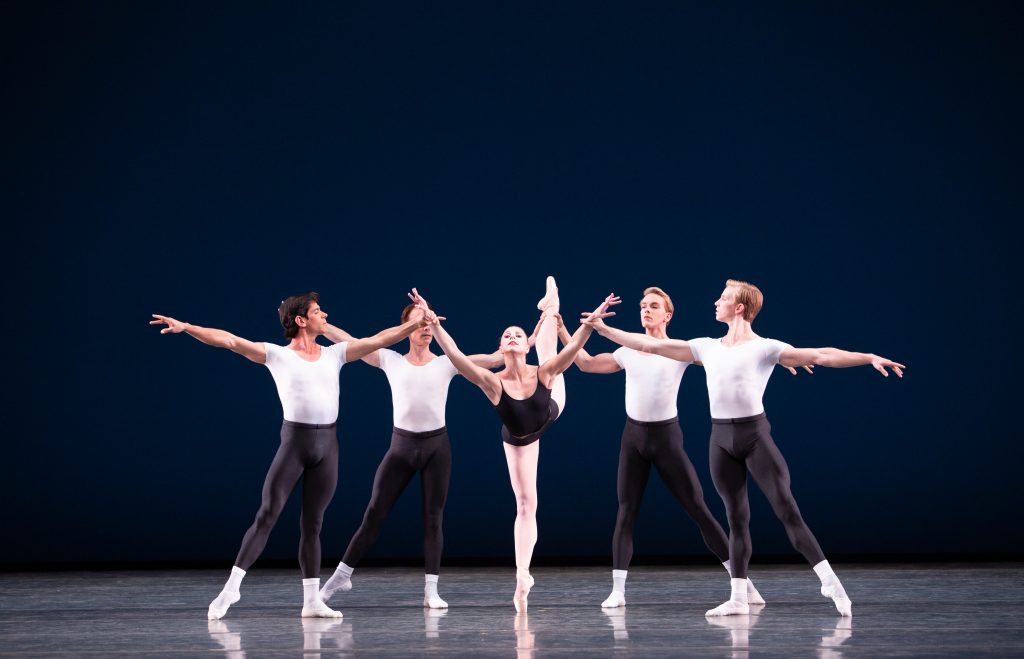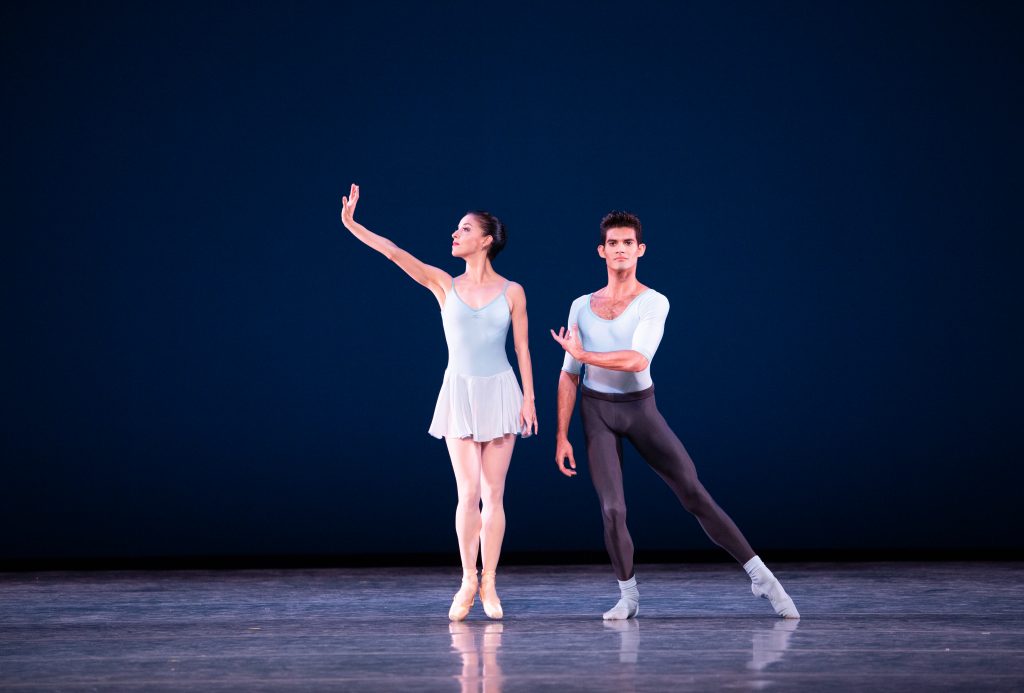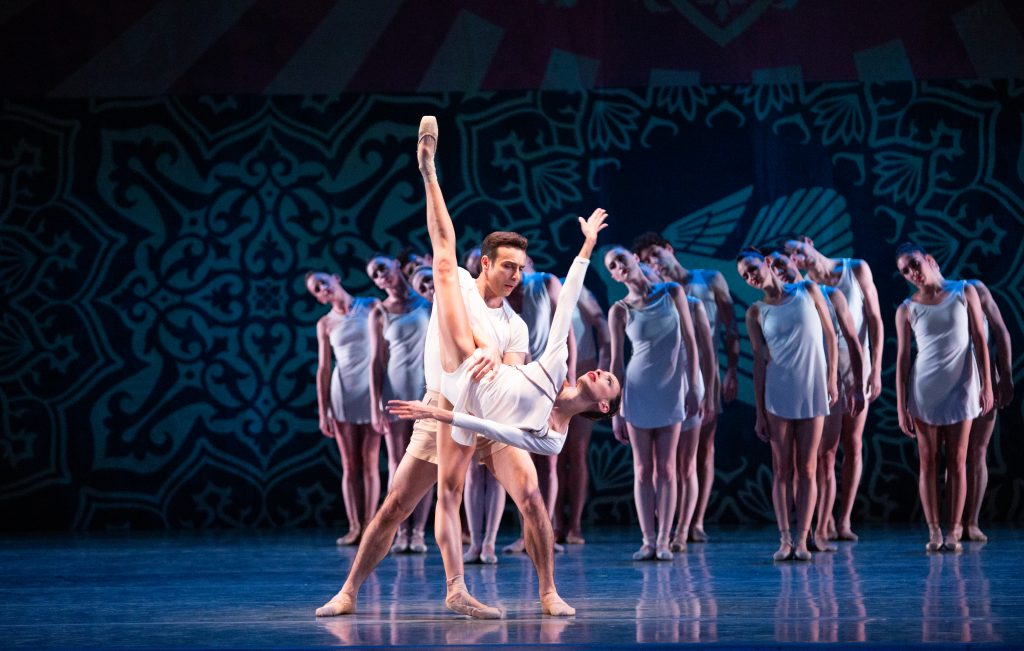
It’s hard to believe the season is almost over. This past weekend, Miami City Ballet presented its Program Three at the Kravis Center and fast on its heels will be its final program, the full-length A Midsummer Night’s Dream by George Balanchine with music by Felix Mendelssohn, which will close out the company’s season in the Palm Beaches on April 4 and 5.
Program Three was everything we have come to expect from MCB. It was well-balanced, well-presented and well-danced. There was a bit of the old, some new (albeit revisited), and an artistic stretch.
Opening the program and making a strong impression was the The Four Temperaments, a 1946 work that Balanchine choreographed for the opening program of the Ballet Society (the forerunner of what is now New York City Ballet). It was in this work that Balanchine, using a commissioned score for string orchestra and piano from composer Paul Hindemith, first introduced his use of angular hip thrusts and off-balance moves fused together with classical ballet vocabulary that later became his signature style. In practice clothes and without scenery, it is a work that is still bold and holds attention.
The 30-minute work, which has 25 dancers (all of whom danced with great articulation and clarity), began with “Theme,” a section led by three couples, and was followed by four variations — “Melancholic,” “Sanguinic,” “Phlegmatic” and “Choleric” — that referred to the four different “humors” that the ancient Greeks thought determined one’s personal temperament, and that also are also associated with the four classical elements — earth, air, water and fire.
Alexander Peters was outstanding in “Melancholic,” commandeering the stage with movement that was full of intent and passion, most notably his execution of a movement that started as an arabesque, transitioned to a front extension, and ended with a dramatic, risk-taking backwards fall. Christine Spigner and Aaron Hilton competently stepped in for Nathalia Arja and Chase Swatosh in “Sanguinic.” Jovani Furlan did not show his usual engaging self in “Phlegmatic,” whereas Lauren Fadley was like a magnet of energy dancing the lead in “Choleric.”

Another Balanchine offering on the program Saturday night was Duo Concertant, a double duet for violinist Mei Mei Luo and pianist Francisco Rennó and principal dancers Katia Carranza and Renan Cerdeiro. Inspired by Igor Stravinsky’s 1932 piece of the same name, Balanchine choreographed this work for his 1972 Stravinsky Festival. During the first movement, the two dancers just stood at the piano and listened to the musicians playing their instruments. Inspired by the music, they drifted off to dance, mirroring the notes in their movements and playfully interacting with each other.
Several times during the different movements, the dancers returned to stand near the musicians and attentively listened to their interpretation of the music. Carranza and Cerdeiro masterfully framed their sensitive and expressive interpretation of the music with their beautiful and pristine technique. There was a moment, so simple but so lovely, when I could see the music in Carranza’s feet as she slipped into her chaîné turns moving away from the piano to continue dancing.
The costumes looked like they were the originals taken right out of the storage box. Cerdeiro’s blue shoes and socks were distractingly vivid and Carranza’s skirt unfortunately was not proportioned to her svelte body. They looked odd, and should be reworked.
The lovely and nuanced Duo Concertant was followed by another duet, the well-known pas de deux from The Flower Festival in Genzano, a 1858 one-act by the Danish choreographer August Bournonville, with music by Edvard Helsted. It was a surprise to see it on a MCB program and one must appreciate the challenge it was to undertake this particular style of classical ballet on Balanchine trained dancers.
Flower Festival has always been a good vehicle to demonstrate the classical Bournonville technique, which emphasizes shaped and placed porte de bras and graceful epaulement presented in contrast to the speed of the footwork (batterie) — all of which should be harmoniously presented in an understated and effortless manner. However, Ashley Knox and Rainer Krenstetter, Saturday night’s cast, seemed out of their element. They both overplayed their roles and looked a little uneasy in the execution of the style. They were unable to catch the music’s rhythm with their less than clear footwork and complement the music’s melody with their loose porte de bras.

Heatscape was the rewarding finish of Program Three. Premiered by MCB in 2015, the highly visual, well structured and buoyantly danced work did not disappoint upon second viewing. In fact, it seemed even more to be the perfect signature contemporary work for this vibrant company.
Justin Peck got everything right with his tony assembly of vital ingredients. Choosing to use the dynamic music of Czech composer Bohuslav Martinů and the strong visual impact of street artist Shepard Fairey’s mandala-inspired artwork, Peck wove a striking link between them and his beautifully crafted movement and floor patterns. He then added to the mix the neutral but trendy costumes of Reid & Harriet Designs and for the finishing touch, the vibrant lighting design of Brandon Stirling Baker, which imbued the entire production with the saturated color of the tropics.
The full spectrum of visuals were rich and stimulating, but what really popped this second time around was the MCB dancers with their boundless energy and focused commitment to the work.
Cerdeiro was the catalyst of the cast and together with Emily Bromberg he ignited the stage, starting with the beginning tumble of movement that began playfully with a still of the 17 ensemble dancers posed upstage against a long dark strip that reminded one of Miami’s Wynwood murals. Moving downstage and interacting with the audience, the dancers then spilled out across the stage letting loose their movement.
The contemporary look in Heatscape had a lot to do with the way Peck played with the traditional modes of ballet’s structure. For example, in the finale ensemble section where he revisited the dancers lined up downstage interacting with the audience, the movement he choreographed — as he moved the dancers back and forth from there to the familiar lines of unison work in the finale — was distinctly “unballetic” looking almost like a movie film run backwards.
Peck also chose to disregard the tradition of highlighting the soloists and instead spliced them in and out of the animation, as he introduce his ongoing, intricate patterns which were reminiscent of the reoccurring designs in Fairey’s huge backdrop.
The nimble, turn-on-a-dime dancer Nathalia Arja sparkled in her duet with Renato Penteado and Jeannette Delgado engagingly danced with Shimon Ito and Peters. Ito and Peters were perfection, dancing side by side exactly matching each other’s explosive energy and articulate technique. Guest conductor Beatrice Jona Affron adroitly led the Opus One Orchestra and piano soloist Ciro Fodere in the rousing close to a first-rate program.